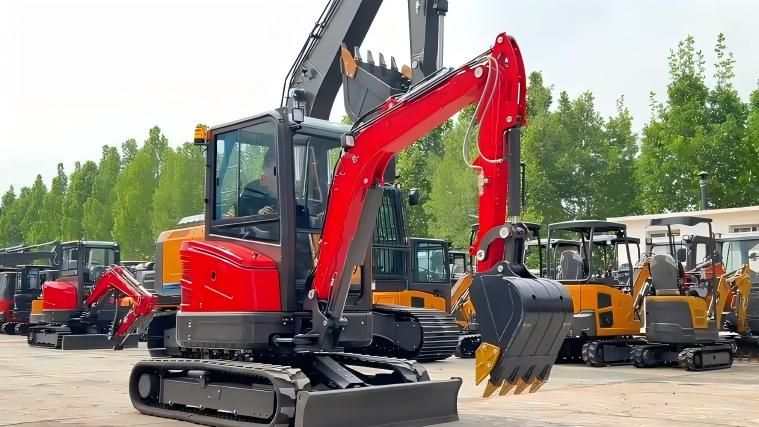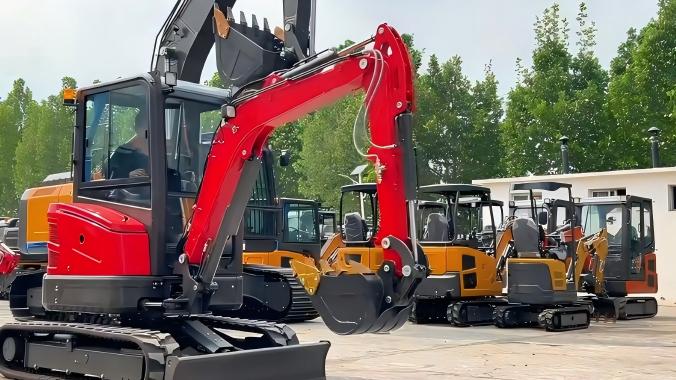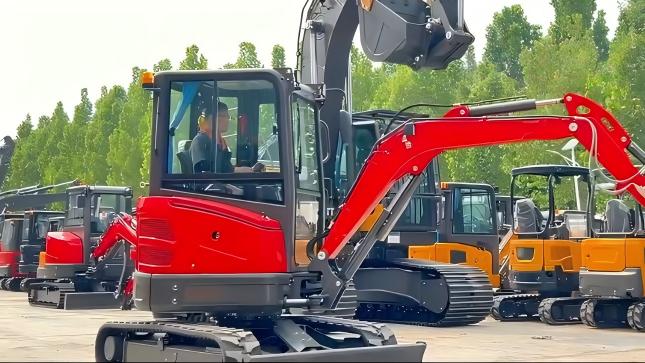Understanding Mini Excavator Fuel Consumption Mini excavators are compact, versatile machines widely used for various tasks, from landscaping and utility work to small-scale construction and demolition. Their appeal lies in their maneuverability in tight spaces and relatively lower operating costs compared to larger excavators. However, fuel consumption remains a significant operating expense, and understanding what influences it is crucial for effective project budgeting and machine management.
Average Fuel Consumption Rates by Size
The most prominent factor influencing fuel consumption is the size and engine horsepower (HP) of the mini excavator. Generally, the larger the machine and the more powerful its engine, the more fuel it will consume.
1-ton Mini Excavators (e.g., Kubota K008-3, Bobcat E10): These smaller models typically have engines around 13.5-25 HP. Their fuel consumption ranges from 1 to 2 liters (0.26 to 0.53 gallons) per hour.
For light work (grading, shallow digging), consumption can be as low as 1 liter/hour.
For medium work (utility trenching), it might be around 1.5 liters/hour.
For heavy, continuous operation in tough conditions, it can go up to 2 liters/hour.
3-ton Mini Excavators: These machines typically consume 3-4 liters per hour.
5-ton Mini Excavators: Expect these larger compact excavators to use 5-6 liters per hour or more.
For example, a Kubota K008-3 (around 1.1 tons, 10.3 HP) might use approximately 1 liter per hour, while a Bobcat E35 (around 3.5 tons, 24.8 HP) could consume closer to 3-4 liters per hour. A Caterpillar 300.9D VPS (around 1 ton, 13 HP) also lists a fuel tank capacity of 10 liters (2.6 gallons), aligning with the lower consumption range.
Key Factors Influencing Fuel Consumption
Beyond machine size, several operational and environmental factors significantly impact a mini excavator's fuel efficiency:
Work Intensity and Application:
Light Work: Tasks like light grading, delicate digging, or moving loose material require less engine power and thus consume less fuel.
Medium Work: Utility trenching, general excavation in typical soil, or loading light materials fall into this category, leading to moderate fuel consumption.
Heavy Work: Breaking concrete with a hydraulic hammer, digging in compacted or rocky ground, continuous deep excavation, or operating power-intensive attachments will significantly increase fuel consumption as the engine works harder.
Operator Technique: A skilled operator can drastically improve fuel efficiency.
Smooth Operations: Avoiding jerky movements, rapid acceleration, and sudden braking reduces strain on the engine and hydraulics.
Optimized Engine RPM: Operating at the lowest effective engine speed (RPM) for the task at hand is crucial. Many modern excavators have "Eco-modes" that automatically adjust engine speed for optimal efficiency.
Minimizing Idling Time: Idling is a major fuel waste. Turning off the engine during breaks or when waiting for material significantly conserves fuel. Some machines feature auto-idle shut-off systems.
Terrain and Ground Conditions:
Rocky or Compacted Ground: Digging in tough conditions requires more force, increasing hydraulic demand and engine load, thus burning more fuel (up to 25% more).
Slopes: Operating on inclines or declines requires more power for stability and movement, pushing consumption towards the upper range.
Loose Soil: Working in easily excavated material is more fuel-efficient.
Attachment Usage:
Hydraulic Attachments: Tools like hydraulic hammers, augers, or grapples place higher demands on the hydraulic system and engine, increasing fuel consumption.
Bucket Size and Type: Using the correct bucket size for the material and task improves efficiency. Oversized buckets can overload the machine, while undersized ones lead to more cycles.
Maintenance and Condition of the Machine:
Engine Tuning: A well-tuned engine with clean fuel and air filters operates more efficiently. Dirty filters restrict airflow and fuel delivery, forcing the engine to work harder.
Hydraulic System: Worn hydraulic pumps or cylinders can reduce efficiency, requiring more power to perform tasks. Leaks in the hydraulic system also lead to wasted energy.
Undercarriage: Proper track tension reduces drag. Worn tracks or rollers can increase rolling resistance.
Lubrication: Regular lubrication of moving parts reduces friction and wear, allowing components to operate smoothly.
Oil and Fluid Quality: Using the manufacturer-recommended oils and fluids ensures optimal lubrication and system performance.
Environmental Conditions:
Temperature: Extreme temperatures can affect fuel consumption.
Hot Weather: Increased cooling demands (fans, air conditioning) can raise fuel use by 10-15%.
Cold Weather: Longer warm-up periods and thicker hydraulic fluid can increase fuel consumption by up to 20%.
Altitude: At higher altitudes, engines can experience a slight loss of power, which might lead to increased fuel consumption to compensate.
Calculating Fuel Consumption
To accurately determine a mini excavator's fuel consumption for a specific job, you can follow these steps:
Fill the Fuel Tank: Start with a full fuel tank.
Record Hour Meter Reading: Note the starting reading on the excavator's hour meter.
Perform Work: Operate the excavator for a defined period (e.g., a full workday or a specific task).
Record Ending Hour Meter Reading: Note the reading on the hour meter after the work is complete.
Refuel and Record Amount: Refill the tank to full and record the amount of fuel added.
Calculate:
Operating Hours: Subtract the starting hour meter reading from the ending reading.
Fuel Consumption Rate (L/hr or gal/hr): Divide the amount of fuel added (in liters or gallons) by the operating hours.
Example: If a mini excavator operates for 8 hours and consumes 12 liters of fuel: Fuel Consumption = 12 liters / 8 hours = 1.5 liters/hour.
Fuel Tank Capacity and Run Time
The fuel tank capacity of mini excavators varies by model and size.Smaller 1-ton excavators might have tank capacities ranging from 8-15 liters (2.1-4 gallons).
Larger mini excavators (e.g., 5-ton) can have significantly larger tanks, sometimes exceeding 80 liters (21 gallons). For instance, a John Deere 30G compact excavator has an 11.1-gallon (42 L) fuel tank. A Caterpillar 308E, an 8-ton class excavator, has a 125L tank.
With typical consumption rates of 1-2 liters per hour for 1-ton machines, operators can expect 6-8 hours of continuous operation from a full tank under normal conditions. This generally means refueling every 1-2 days for an average workday.
Tips to Improve Fuel Efficiency
Optimizing fuel consumption is key to reducing operating costs. Here are some practical tips:
Minimize Idling: Turn off the engine if the machine will be idle for more than a few minutes. Modern engines don't require extensive warm-up or cool-down periods.
Smooth Operation: Encourage operators to use smooth, fluid movements rather than abrupt actions.
Use Eco Mode/Power Modes: Utilize the excavator's "Eco-mode" or lower power settings when the task doesn't demand full power.
Regular Maintenance: Adhere strictly to the manufacturer's maintenance schedule. Clean air and fuel filters, correct oil levels, proper lubrication, and well-maintained hydraulics are critical.
Match Machine to Task: Don't use an oversized excavator for a small job, or vice-versa. Using the right machine size for the task ensures optimal efficiency.
Proper Attachment Selection: Choose the correct bucket size and type for the material being handled. Ensure attachments are in good condition (e.g., sharp bucket teeth).
Efficient Job Site Layout: Plan the work area to minimize travel distances and unnecessary movements.
Monitor Tire Pressure/Track Tension: For wheeled mini excavators, proper tire pressure reduces rolling resistance. For tracked machines, correct track tension prevents excessive drag.
Operator Training: Invest in training for operators on fuel-efficient operating techniques.
Telematics Monitoring: Use telematics systems, if available, to track real-time fuel consumption, identify excessive idling, and monitor machine performance for inefficiencies.
Conclusion
The fuel consumption of a mini excavator is a dynamic figure influenced by its size, the nature of the work, operator skill, maintenance, and environmental conditions. While smaller 1-ton models are highly fuel-efficient, consuming around 1-2 liters per hour, larger units will naturally require more. By understanding these factors and implementing best practices in operation and maintenance, owners and operators can significantly optimize fuel efficiency, reduce operating costs, and maximize the productivity of their mini excavators.
Post time:Sep-25-2020



